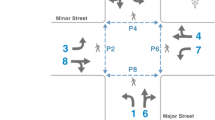Abstract
In this paper we describe the design processes of human traffic engineers and the development of an automated system that solves the problem of timing adjustment in signal phase sequence design. Signal phase sequencing refers to the sequence of signal changes and the timing of each change for a system of traffic lights at an isolated intersection. In designing signal sequences, one must decide how much time to allocate for each phase of the sequence so that traffic can flow with a minimum of delay. Other automated phase design systems can generate an initial phase design, but if the initial design is not precisely correct, the timing sequence must be adjusted by hand. This paper presents TIMELY, an automated signal phase design generator that generates an initial phase design and automatically adjusts the timing if necessary. TIMELY uses an interactive redesign strategy which largely mimics that used by human experts. The system invokes a set of redesign rules (which we have dubbed the “Robin Hood” procedure), gathered from human experts, which tweak the phase design. The new design is fed back into a simulator and tested again. The process stops when we find that the average delay is not improved. We take the design from the previous step as our final design. An expert has verified the soundness of all of TIMELY's results.
Similar content being viewed by others
Explore related subjects
Discover the latest articles, news and stories from top researchers in related subjects.References
J.S. Linkenheld, R.F. Benekohal, and Garrett, Jr. J.H. “Knowledge-based systems for design of signalized intersections,” Journal of Transportation Engineering, vol. 118, no. 2, 1992.
N. Gartner, “Demand-responsive traffic signal control research,” Transportation Research A, vol. 19A, no. 5/6, 1985.
H.R. Kirby, and F.O. Montgomery, “Towards a rule-based approach for traffic signal design,” Civil Engineering Systems, vol. 4, March 1987.
E.C. Chang, “Interactive intersection design using expert systems approach,” Transportation Research Record, 1239, 1989.
G. Scemama, “Signal plan design for complex intersections: A constraint satisfaction programming approach,” in Proceedings of the Eighth International Conference on Road Traffic Monitoring and Control, April 23-25, 1996.
A. Faghri and M.J. Demetsky, “A demonstration of expert systems applications in transportation engineering,” Final Report for Virginia Department of Transportation, vol. I, 1987, vol. II, 1989.
B. Han and S. Yagar, “Real-time control of traffic with bus and streetcar interaction,” IEEE Sixth International Conference on Road Traffic Monitoring and Control, April 28-30, 1992.
F.B. Lin, “Knowledge base on semi-actuated traffic-signal control,” Journal of Transportation Engineering, vol. 117, no. 4, 1991.
S.G. Ritchie, “Real-time expert systems in the California ATMS test,” presentation at Transportation Research Board 72nd Annual Meeting, January 10-14, 1993.
B. Wolshon and W. Taylor, “Analysis of intersection delay under real-time adaptive signal control,” Transportation Research: Part C, Emerging Technologies, vol. 7C, no. 1, 1999.
H. Lo, “A novel traffic signal control formulation,” Transportation Research: Part A, Policy and Practice, vol. 33A, no. 1, 1999.
C. Zozaya-Gorostiza and C. Hendrickson, “Expert system for traffic signal setting assistance,” Journal of Transportation Engineering, vol. 113, no. 2, 1987.
D.A. Bryson and J. Stone, “Intersection advisor: an expert system for intersection design,” Transportation Research Record, vol. 1145, 1987.
E.C. Chang, “Deciding alternative left signal phases using expert systems,” ITE Journal, January 1988.
S.B. Pattnaik, S. Rajeev, and A. Mukundan, “Toward intelligent traffic signal design system,” Journal of Transportation Engineering, vol. 117, no. 5, 1991.
M. Hadi, “Hybrid genetic algorithm to optimize signal phasing and timing,” Transportation Research Record, 1993.
Z. Khatib and P. Coffelt, “Traffic signal controller interface,” in Proceedings of the 69th Annual Meeting of the Institute of Transportation Engineers, 1999.
J.M. Schmitz and S. Desa, “The Application of a Design for Predictability Methodology to Complex Stamped Product,” Concurrent Product and Process Design, pp. 169-174, 1989.
J.R. Dixon, A. Howe, P.R. Cohen, and M.K. Simmons, “Dominic I: Progress toward domain independence in design by iterative redesign,” Engineering with Computers 2, Springer-Verlag, New York, pp. 137-145, 1987.
M.F. Orelap, J.R. Dixon, P.R. Cohen and M.K. Simmons, “Dominic II: Meta-level control in iterative redesign,” in Proceedings of the National Conference on Artificial Intelligence (AAAI), 1988.
Webster, “Traffic signal setting,” Road Research Technical Paper No. 39, 1958.
Author information
Authors and Affiliations
Rights and permissions
About this article
Cite this article
Wang, L., Hayes, C. & Penner, R. Automated Phase Design and Timing Adjustment for Signal Phase Design. Applied Intelligence 15, 41–55 (2001). https://doi.org/10.1023/A:1011218724416
Issue Date:
DOI: https://doi.org/10.1023/A:1011218724416




